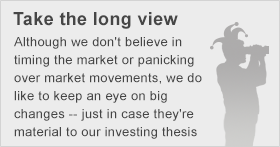Mixed, but stabilizing, economic data was the name of the game today that helped push the broad-based S&P 500 (SNPINDEX: ^GSPC) higher, practically erasing almost all of yesterday's losses.

As per the norm, we got initial weekly jobless claims data today, which showed a less than 2% increase to a seasonally adjusted 320,000. In a perfect world, we never want to see jobless claims rise, but a figure of 320,000 appears low enough to warrant an ongoing drop in the unemployment rate.
What really seemed to invigorate investors today was a surprising 0.5% jump in leading indicators for February after a tame 0.1% rise in January, and a 0.1% decline in December. This big jump gives investors hope that the U.S economy will rebound voraciously from its early season weather-induced slump.
On the flip side, existing home sales data continues to be weak. February's data showed a decline of 0.4% to a seasonally adjusted annual rate of 4.6 million, matching economists' expectations, but also hitting their lowest levels since July 2012. Although low inventories are helping home prices, the precarious drop in mortgage originations anytime interest rates have even the slightest uptick is concerning.
Despite the mixed data, the S&P 500 pushed higher by 11.24 points (0.60%) to close at 1,872.01.
Topping the charts today was China-based infectious disease vaccine developer Sinovac Biotech (SVA +0.00%), which jumped 17.1% after reporting its fourth-quarter results. For the quarter, Sinovac saw sales increase 17%, to $22.9 million, as it reported net income of $0.10 per share compared to a net loss of $0.08 per share in Q4 last year. By comparison, Wall Street was looking for Sinovac to report a loss of $0.01 per share, so this was a sizable beat. While sales of comparable products (e.g., hepatitis and influenza vaccines) actually fell 19% year over year, the addition of an H5N1 vaccine produced $7.2 million in revenue, which helped propel Sinovac higher. It's hard to argue against a company focused on treating infectious diseases given that so many countries around the world still lack access to these basic vaccines, but at 50 times forward earnings, much of that optimism may already be baked into Sinovac's share price.
Sticking with our theme of earnings-driven events, discount branded retail and accessories chain Burlington Stores (BURL +0.28%) gained 15.8% after reporting market-topping profits in the fourth quarter. Profit for the quarter dipped to $1.07 per share from $1.15 in the year-ago quarter, but handily surpassed the $1.03 per share that Wall Street expected. The results, though, were largely mixed, with comparable-store sales growing 4% during the quarter and signaling robust growth; yet, its first-quarter EPS forecast of $0.19-$0.23 in EPS bracketed a bit lower than Wall Street's forecast of $0.23 per share. Overall, I'm a bit put off by Burlington, which is valued at 21 times forward earnings, and is only forecasting same-store sales growth of 2%-3% in the upcoming year. I believe there are considerably more attractive places to put your money to work in the retail sector.
Finally, clinical-stage biopharmaceutical company ZIOPHARM Oncology (ZIOP +4.06%) jumped 11.8% following a rating initiation from Mizuho Financial Group. Mizuho, in a research note released last night, started ZIOPHARM with a buy rating and an $11 price target, implying 127% potential upside based on yesterday's close. Mizuho notes that ZIOPHARM's exclusive use of Intrexon's (XON +1.88%) RheoSwitch Therapeutic System for use in developing new oncology-based therapies could give it a unique advantage that may result in positive readouts this year. While ZIOPHARM's pipeline does offer promise, I remain cautious about that it only has two ongoing phase 2 clinical studies, and a number of preclinical studies. Until its pipeline becomes more mature, I'd prefer to stay on the sidelines.
